Key takeaways
- French photography captures the essence of the nation’s culture and history, evoking emotions through visual storytelling.
- Lightroom is a crucial tool for editing, offering features that enhance image quality and organization.
- Understanding light and composition is vital for impactful photography, using techniques like leading lines and the golden hour to create depth.
- Editing tips include adjusting shadows and contrast to reveal hidden details and enhance vibrancy without oversaturation.
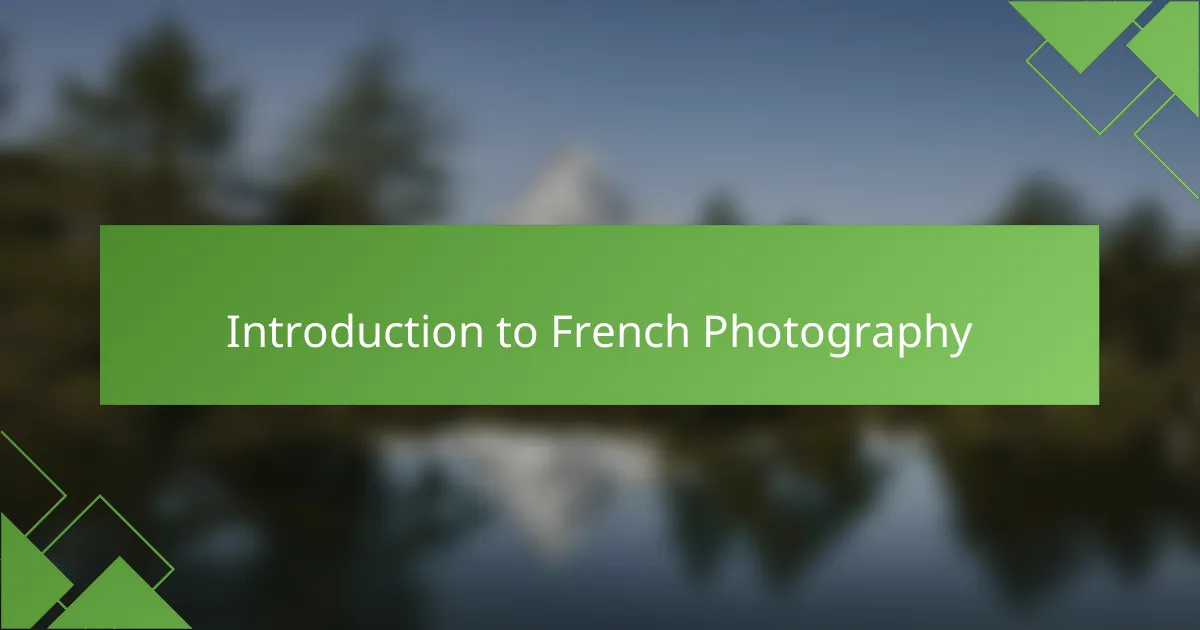
Introduction to French Photography
French photography is more than just a visual art; it’s a lens through which we capture the soul of a nation. I remember strolling along the Seine, my camera poised, feeling the pulse of Paris—each click of my shutter was a conversation with the city. Isn’t it fascinating how a single photograph can evoke emotions and tell stories that words sometimes fail to capture?
The streets of France are alive with history and culture, offering endless inspiration to photographers. I often find myself wondering what stories the cobblestones might tell if they could speak. Whether it’s the delicate light filtering through a bustling bistro or the shadow of a vintage lamppost at dusk, every scene invites us to explore its depths.
As I reflect on my own journey in photography, I realize that capturing these moments is about connection—between the photographer, the subject, and the viewer. What do you feel when you look at a captivating photograph? For me, it’s an instant reminder of the beauty that surrounds us and the memories waiting to be expressed.
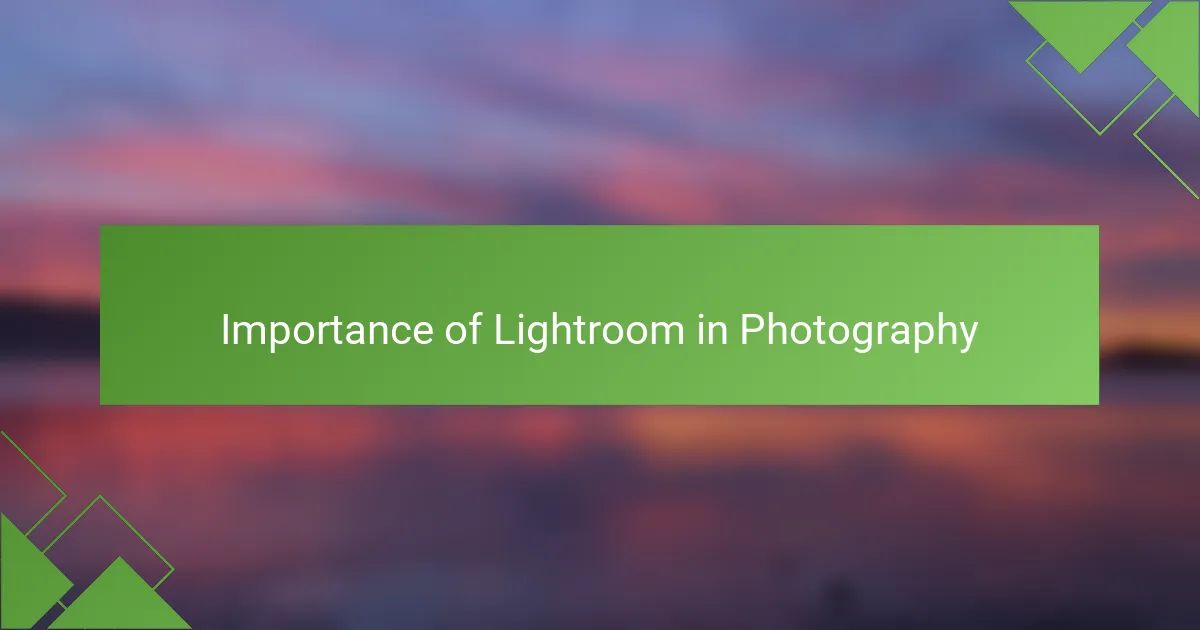
Importance of Lightroom in Photography
Lightroom has become an essential tool in my photography workflow, especially when it comes to capturing the vibrant essence of Parisian streets. I remember the first time I imported my images into Lightroom after a day of wandering through Montmartre. The ability to enhance colors and adjust lighting so seamlessly filled me with excitement and made each photo truly come alive, allowing me to recreate the atmosphere I felt in those moments.
The versatility of Lightroom cannot be overstated. It not only helps in organization but also in the creative editing process, which is vital for expressing the emotions tied to those experiences.
Here’s a quick list highlighting some of the importance of Lightroom in photography:
- Powerful editing tools for precise adjustments, such as exposure and contrast.
- Easy-to-use interface that allows quick edits and transformations.
- Presets that can help achieve consistent looks across your portfolio.
- Organizational features that keep your images easily accessible.
- Ability to compare multiple edits side by side for better decision-making.
Using Lightroom has truly transformed how I share my experiences with the world, enriching the story behind each photo I take.

Understanding Light and Composition
When I first started capturing the vibrant streets of Paris, I quickly realized that light is as essential as the camera itself. I often found that the golden hour, just after sunrise or before sunset, casts a magical glow on the city, enhancing the historic architecture and dynamic street life in ways I could hardly believe. Composition, on the other hand, is about storytelling; each photograph I took had to convey an emotional connection to not just the scene, but also to the atmosphere that enveloped it.
Over time, I learned to look for leading lines and the rule of thirds, which helped guide the viewer’s eye through my images. For instance, while photographing the quaint cobblestone streets of Montmartre, positioning the main subject off-center allowed me to showcase the lively street cafes and artists at work. It’s fascinating how a slight shift in perspective can completely transform an image’s impact.
To further illustrate my thoughts on light and composition, I’ve created a simple comparison table to highlight the key differences between the two:
| Aspect | Description |
|---|---|
| Light | Essential for mood and atmosphere, affects colors and textures. |
| Composition | Arrangement of elements in the frame, guides the viewer’s eye. |
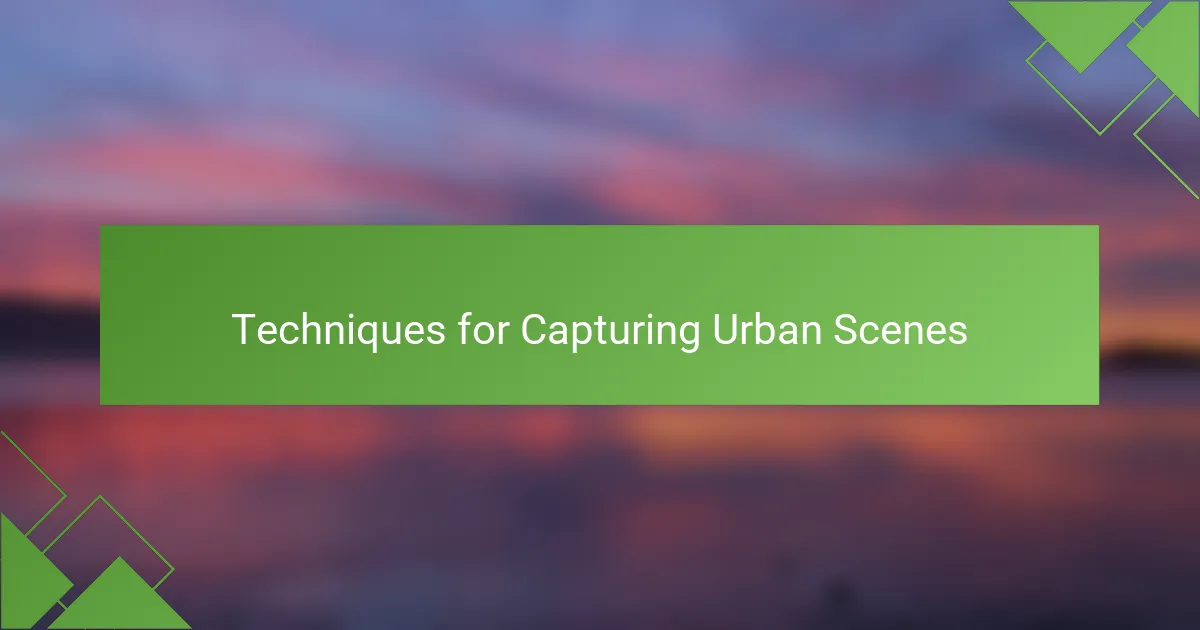
Techniques for Capturing Urban Scenes
When I set out to capture the essence of Parisian streets, I quickly realized that techniques can make or break your urban photography. One method that stood out for me was the use of leading lines. I found that framing a shot with the iconic Haussmannian architecture naturally drew my eye into the scene, creating depth and interest. It was indeed exhilarating to watch a simple street corner transform into a captivating composition.
Beyond leading lines, I found that shooting during the golden hour added a magical touch to my images. The soft, warm light flattered the buildings and added an ethereal quality to my captures. I remember wandering through Montmartre, feeling an overwhelming sense of inspiration as the sun dipped below the rooftops, casting long shadows across the cobblestones. Here are some key techniques that I often use for urban scenes:
- Utilize leading lines to guide the viewer’s eye through the image.
- Experiment with varying angles (high and low shots) to gain unique perspectives.
- Time your shoots with the golden hour for soft, flattering light.
- Focus on capturing candid moments of city life to convey the vibrancy of urban environments.
- Try layering your compositions to create depth through foreground, midground, and background elements.
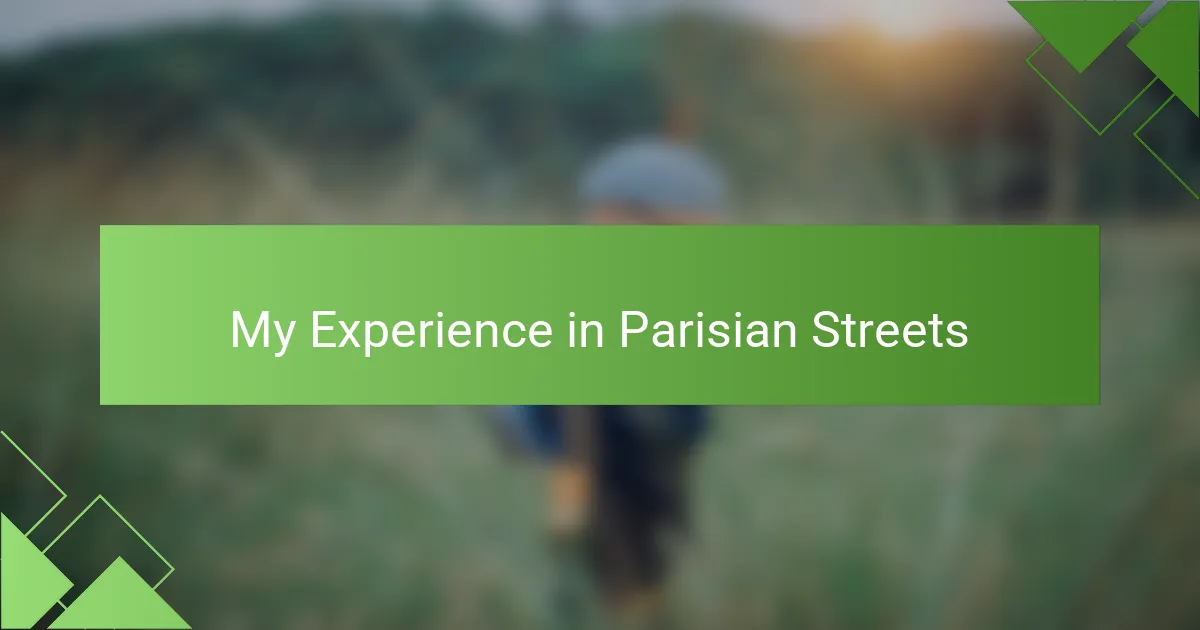
My Experience in Parisian Streets
Walking through the Parisian streets was like stepping into a living canvas. Each corner revealed a new story, whether it was the laughter of café-goers or the soft whispers of history echoing off the cobblestones. I can still remember the thrill when I captured a perfect sunset over the Seine; it felt magical, almost surreal.
As I wandered the vibrant markets, the rich textures and colors inspired me to experiment with my camera settings. One moment, I was taking a candid shot of a street performer, and the next, I was adjusting my lens to capture the intricate details of a rustic bakery. It was a dance of creativity and spontaneity that left me exhilarated.
| Aspect | My Parisian Experience |
|————————-|—————————–|
| Mood | Vibrant and Lively |
| Key Subject | Street Performers and Cafés |
| Best Moment Captured | Sunset over the Seine |
| Emotional Insight | Sense of Awe and Inspiration |
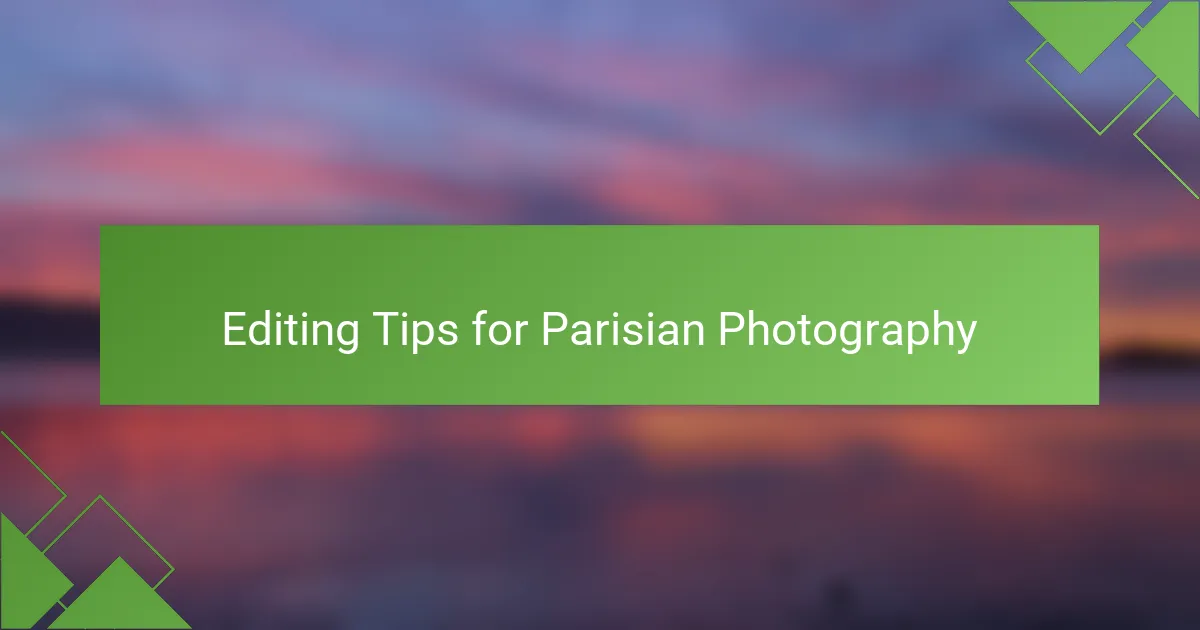
Editing Tips for Parisian Photography
When editing my Parisian street photos in Lightroom, I often focus on enhancing the light and colors to capture the unique atmosphere of the city. I remember wandering through Montmartre, where the golden hour turned ordinary scenes into magical moments. Adjusting the contrast and vibrance can really bring out the vibrancy of the buildings and the mood of the streets.
One key tip is to experiment with the shadows and highlights; this can add depth to your photos. I often find that boosting the shadows slightly reveals hidden details, especially in the charming alleyways of Le Marais. It’s like unveiling a secret world that makes you feel more connected to the city.
Finally, don’t forget about cropping and straightening your images. I once had a shot of the Eiffel Tower that was slightly tilted, which didn’t do justice to its majestic presence. A simple adjustment made all the difference and allowed me to share the beauty I experienced that day.
| Editing Technique | Purpose |
|---|---|
| Boost Shadows | Reveal hidden details and add depth |
| Adjust Contrast | Enhance the dynamic range |
| Increase Vibrance | Make colors pop without oversaturating |
| Cropping/ Straightening | Focus viewer’s attention |